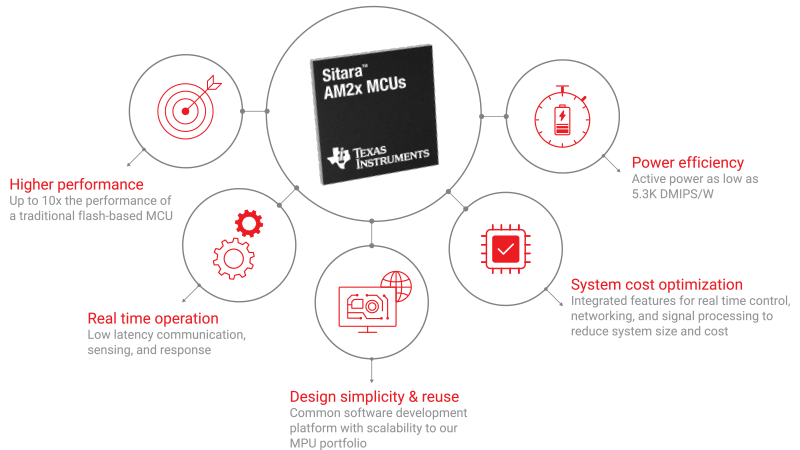Advances in automated factories and smart vehicles require advanced networking capabilities, real-time processing, analytics at the edge and more advanced motor-control topologies. These examples illustrate the rapidly growing need for a high-performance microcontroller (MCU) that can outpace traditional MCUs and deliver processor-like capabilities. In this article, I’ll cover five ways that high-performance Sitara AM2x MCUs are helping design engineers address current and future system challenges, as illustrated in Figure 1.

Figure 1: Benefits of Sitara AM2x high-performance MCUs
Enabling higher performance
MCUs have seen recent advancements in memory size, analog function integration and low power consumption. But in many applications, the ability to process high volumes of real-time control and sensor data quickly is just as critical. In an automated factory, the processing requirements for programmable logic controllers (PLCs) and robot motor-control systems have increased from approximately 100 MHz per core to over 400 MHz, and potentially to more than 1 GHz over the next three to five years.
MCUs also need high performance capabilities to handle functions including:
- Increased industrial communications, since machines and central data systems share large volumes of data across a variety of protocols.
- Analytics at the edge for predictive maintenance that keeps factories running smoothly.
Sitara AM2x MCUs meet higher performance requirements by increasing the clock speed of each MCU core, and by integrating multiple MCU cores on the same chip. With four cores running at 800 MHz each, the AM2434 enables faster and more complex data processing, lower latency control, and high-speed communications on factory floors than what’s available in a traditional MCU. Faster and smoother control of robotic arms, for example, can enhance operational safety, production efficiency, quality and throughput.
Improving real-time operation and analytics
With more automation in modern factories, the need for real-time data analytics and control increases. Many traditional systems have multiple MCUs handling these different functions. High-performance MCUs, especially those with multicore architectures, can enable more integrated systems by managing data processing and real-time control functions on a single device.
Sitara AM2x MCUs integrate fast data-acquisition capabilities and precise real-time control peripherals to input and process data at high speeds. Imagine that a single MCU controlling the motor for a robotic arm also integrates audio, current and position sensing interfaces to improve safety in robot-human collaboration without the need for additional MCUs. Or that an MCU integrates audio input, sound recognition and classification to improve edge intelligence in a building’s security system. By enabling multiple processing capabilities on a single chip, high-performance MCUs can not only make industrial systems smarter, but more affordable and easier to design.
Simplifying designs and enabling software reuse
The defining characteristics of MCUs include simple system design and software development. The expectations of easy-to-use hardware and software won’t change, even as MCU performance and integration levels become more similar to those of a processor.
With Sitara AM2x MCUs, engineers can continue to experience:
- Simple software development environments and tools (such as real-time operating system-based software) that enable reuse across platforms, reducing development time and cost.
- Efficient management of real-time tasks and simpler power-management architectures for more cost-effective power-management solutions.
- Optimized speed and low-latency functions as a result of integrated random-access memory (RAM).
A real-time sensing and reaction application such as a PLC must process timing constraints for safety and continuous operation. This means that systems need designing for worst-case timing. Providing easy-to-use software helps you quickly and efficiently design such systems.
Optimizing system cost through memory flexibility
Traditional MCUs have onboard nonvolatile memory, such as flash. But increased data processing requirements in applications ranging from automated factories to autonomous driving present memory-size scalability challenges. In addition, faster central processing unit requirements present two challenges:
- A complete dependence on throttling flash speed and performance, especially where the system needs real-time writing to memory.
- Limited to no nonvolatile memory support for more advanced processing nodes, such as 16 nm.
MCU design engineers can benefit from the flexibility of an external nonvolatile memory architecture. With Sitara AM2x MCUs, you can address increased memory needs without changing the MCU or redesigning the board, leading to a nimbler design and lower development costs. The large onboard RAM and simple software architecture of AM2x devices address latency and performance concerns around external memory.
Increasing power efficiency
Traditional MCUs are known for their low power consumption, and reducing power consumption remains critical as applications move toward high-performance MCUs. Power efficiency manifests along two vectors that matter to designers:
- Performance per watt (active power-consumption efficiency). Increased heat dissipation beyond 2 W to 3 W often leads to cost, weight and footprint concerns in traditional MCU systems, especially those that need active cooling measures such as heat sinks and fans. Increased performance therefore cannot come with proportional power-consumption increases. High-performance Sitara AM2x MCUs can support performance of over 5,000 DMIPS/W.
- Low-power (power-down) modes. MCUs typically operate in lower duty-cycle environments, and given the fact that high-performance MCUs are designed in advanced process nodes, their leakage current impact is higher than traditional MCUs. Designers need continued innovation in power-gating techniques and low-power modes such as sleep, deep sleep, shut down, real-time clock only and input/output wakeup.
Conclusion
High-performance MCUs are making processor-level computing more accessible, unlocking new doors for designers and systems. As applications continue to evolve and design engineers harness the full potential of high-performance MCUs in their systems, MCU innovators, product designers and consumers will all experience the benefits of their newfound capabilities.
The post 5 Ways High-performance MCUs are Reshaping the industry appeared first on ELE Times.
No comments:
Post a Comment